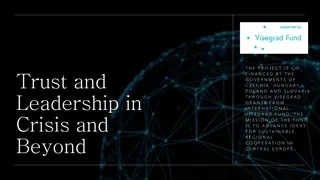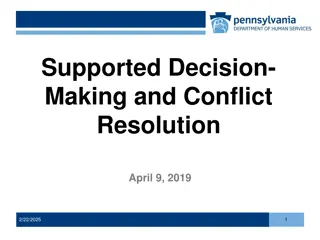
Leadership and Decision Making Overview
This chapter delves into various leadership approaches, including transformational and charismatic perspectives, leadership substitutes and neutralizers, and contemporary issues in leadership. It also explores strategic, ethical, and virtual leadership, as well as the relationship between leadership and decision making from rational and behavioral perspectives.
Download Presentation

Please find below an Image/Link to download the presentation.
The content on the website is provided AS IS for your information and personal use only. It may not be sold, licensed, or shared on other websites without obtaining consent from the author. If you encounter any issues during the download, it is possible that the publisher has removed the file from their server.
You are allowed to download the files provided on this website for personal or commercial use, subject to the condition that they are used lawfully. All files are the property of their respective owners.
The content on the website is provided AS IS for your information and personal use only. It may not be sold, licensed, or shared on other websites without obtaining consent from the author.
E N D
Presentation Transcript
Chapter 9 Leadership and Decision Making Prepared By Mostafa Kamel
Chapter Overview This chapter focuses on several approaches to leadership and describes transformational and charismatic perspectives on leadership. It also looks at types of leadership substitutes and neutralizers, as well as several contemporary issues in leadership seeing leaders as coaches and examining gender and cross-cultural issues in leadership. This chapter also: Discusses strategic leadership, ethical leadership, and virtual leadership. Relates leadership to decision making. Discusses both rational and behavioral perspectives on decision making. Prepared By Mostafa Kamel
Learning Objectives Define leadership and distinguish it from management. Summarize early approaches to the study of leadership. Discuss the concept of situational approaches to leadership. Describe transformational and charismatic perspectives on leadership. Identify and discuss leadership substitutes and neutralizers. Discuss leaders as coaches and examine gender and cross-cultural issues in leadership. Describe strategic leadership, ethical leadership, and virtual leadership. Relate leadership to decision making and discuss both rational and behavioral perspectives on decision making Prepared By Mostafa Kamel
Chapter Outline THE NATURE OF LEADERSHIP The Changing Nature of Leadership Leaders as Coaches Gender and Leadership Cross-Cultural Leadership EARLY APPROACHES TO LEADERSHIP TRAIT APPROACHES TO LEADERSHIP BEHAVIORAL APPROACHES TO LEADERSHIP Emerging Issues in Leadership Strategic Leadership Ethical Leadership Virtual Leadership The Situational Approach to Leadership Leadership Through the Eyes of Followers Transformational Leadership Charismatic Leadership Leadership, Management, and Decision Making Rational Decision Making Behavioral Aspects of Decision Making Special Issues in Leadership Leadership Substitutes Leadership Neutralizers Prepared By Mostafa Kamel
The Nature of Leadership Prepared By Mostafa Kamel
What is Leadership Leadership: is the processes and behaviors used by someone, such as a manager, to motivate, inspire, and influence the behaviors of others. Prepared By Mostafa Kamel
Leadership focus Vs. Management focus Organizations management and leadership if they are to be effective. Management with leadership can help achieve planned orderly change. Leadership with management can keep the properly aligned environment. need both organization with its Prepared By Mostafa Kamel
Early Approaches to Leadership Prepared By Mostafa Kamel
Evolution of Leadership Studies A. Early studies focused on the traits, or personal characteristics, of leaders. B. Later research shifted to examine actual leader behaviors. Prepared By Mostafa Kamel
A. Trait Approaches to Leadership Focused on identifying the essential traits that Distinguished leaders Early researchers believed that effective leaders had some unique set of qualities or traits that distinguished them from their peers: Dominance. self-confidence. Energy. Activity (versus passivity). Knowledge about the job. Recent studies started to include other traits such as emotional intelligence, mental intelligence, and honesty and integrity. Prepared By Mostafa Kamel
B. Behavioral Approaches to Leadership Focused on determining what behaviors are employed by leaders This research led to the identification of two basic forms of leader behavior: Task-Focused Leader Behavior: leader behavior focusing on how tasks should be performed in order to meet certain goals and to achieve certain performance standards. Employee-Focused Leader Behavior leader Behavior focusing on satisfaction, motivation, and well-being of employees. Prepared By Mostafa Kamel
The Situational Approach to Leadership Prepared By Mostafa Kamel
Situational Approach to leadership Situational Approach to Leadership assumes that appropriate leader behavior varies from one situation to another. Leadership characteristics include the manager s value system, confidence in subordinates, personal inclinations, feelings of security, and actual behaviors. Subordinate characteristics include the subordinates need for independence, Readiness to assume responsibility, tolerance for ambiguity, interest in the problem, understanding of goals, knowledge, experience, and expectations. Situational characteristics that affect decision making include the type of organization, group effectiveness, the problem itself, and time pressures. Prepared By Mostafa Kamel
Leadership Through the Eyes of Followers Prepared By Mostafa Kamel
Leadership Through the Eyes of Followers Focuses on how leaders are seen through the eyes of their followers. The two primary approaches to leadership through the eyes of followers are: 1. Transformational leadership 2. Charismatic leadership. Prepared By Mostafa Kamel
1. Transformational Leadership Transformational Leadership the set of abilities that allows a leader to : Recognize the need for change. Create a vision to guide that change. Execute the change effectively. Prepared By Mostafa Kamel
2. Charismatic Leadership Charismatic leadership is a type of influence based on the leader s charisma, Charisma: is a form of interpersonal attraction that inspires support and acceptance. Charismatic leaders are likely to: Have a lot of confidence in their beliefs. Have a strong need to influence people. Tend to communicate high expectations about follower performance. To express confidence in their followers. Prepared By Mostafa Kamel
Special Issues in Leadership Prepared By Mostafa Kamel
Another interesting perspective on leadership focuses on alternatives to leadership. In some cases, certain factors may actually substitute for leadership, making actual leadership unnecessary. In other cases, factors may exist that neutralize or negate the influence of a leader even when that individual is attempting to exercise leadership. Prepared By Mostafa Kamel
Leadership Substitutes Leadership Substitutes: is an individual, task, and organizational characteristics that tend to outweigh the need for a leader to initiate or direct employee performance. It assumes that if certain factors are present, the employee will perform his or her job capably, without the direction of a leader. Prepared By Mostafa Kamel
Leadership Neutralizers Leadership Neutralizers: factors that may render leader behaviors ineffective. The following table identifies several basic leadership substitutes and neutralizers. Prepared By Mostafa Kamel
Leadership Substitutes and neutralizers Prepared By Mostafa Kamel
The Changing Nature of Leadership Among the recent changes in leadership that managers should recognize are the increasing role of leaders as coaches as well as gender and cross-cultural patterns of leader behavior. Prepared By Mostafa Kamel
Leaders as Coaches From the standpoint of a business leader, a coaching perspective would call for the leader to: Help select and train team members and other new employees. To provide some general direction. Help the team get the information and other resources it needs. Play important roles in linking the activities and functions of their respective teams. Prepared By Mostafa Kamel
Gender and Leadership Another factor that is clearly altering the face of leadership is the growing number of women advancing to higher levels in organizations. The one difference that has arisen in some cases is that women may be slightly more democratic in making decisions, whereas men have a tendency to be more autocratic. Prepared By Mostafa Kamel
Cross-Cultural Leadership Japan is generally characterized by collectivism (group before individual), whereas the United States is based more on individualism (individual before group). So when a Japanese firm sends an executive to head up the firm s operation in the United States, that person will likely find it necessary to recognize the importance of individual contributions and rewards and the differences Prepared By Mostafa Kamel
Emerging Issues in Leadership There are three emerging issues in leadership that warrant discussion. These issues are strategic leadership, ethical leadership, and virtual leadership. Prepared By Mostafa Kamel
Strategic Leadership Strategic Leadership leader s ability to understand the complexities of both the organization and its environment and to lead change in the organization so as to enhance its competitiveness. To be effective as a strategic leader: A leader needs to have a thorough and complete understanding of the organization (its history, its culture, its strengths, and its weaknesses). The leader needs a firm grasp of the organization s external environment. Prepared By Mostafa Kamel
Ethical Leadership Ethical Leadership leader behaviors that reflect high ethical standards. Business leaders are being called on to: Maintain high ethical standards for their own conduct. To exhibit ethical behavior. To hold others in their organizations to the same standards. Prepared By Mostafa Kamel
Virtual Leadership In today s world, both leaders and their employees may work in locations that are far from one another. Virtual leadership: leadership in settings where leaders and followers interact electronically rather than in face-to-face settings. Managers can instead make a point of adding a few personal words in an e-mail to convey appreciation, reinforcement, or constructive feedback. Prepared By Mostafa Kamel
Leadership, Management, and Decision Making Prepared By Mostafa Kamel
Rational Decision Making Managers and Leaders must frequently make decisions. Managers and leaders should strive to be rational in making decisions. Prepared By Mostafa Kamel
Behavioral Aspects of Decision Making These include 1. Political forces in decision making 2. Intuition 3. Escalation of commitment 4. Risk propensity. Prepared By Mostafa Kamel
1. Political forces in decision making One major element of politics is coalitions. A Coalitions is an informal alliance of individuals or groups formed to achieve a common goal. When these coalitions enter the political arena and attempt to persuade lawmakers to make decisions favorable to their interests, they are called lobbyists. Lobbyists may also donate money to help elect a candidate who is more likely to pursue their agendas. Prepared By Mostafa Kamel
2. Intuition Intuition: is an innate belief about something, often without conscious consideration. For instance, Managers sometimes decide to do something because it feels right . Usually not arbitrary but based on their years of experience and practice. Prepared By Mostafa Kamel
3. Escalation of Commitment Escalation of Commitment: is the condition in which a decision maker becomes so committed to a course of action that she or he stays with it even when it appears to have been wrong. Prepared By Mostafa Kamel
4. Risk Propensity and Decision Making Risk propensity: Is the extent to which a decision maker is willing to gamble when making a decision. Some managers are very cautious and conservative, others are aggressive in making decisions. The organization s culture is a prime ingredient in fostering different levels of risk propensity. Prepared By Mostafa Kamel






















